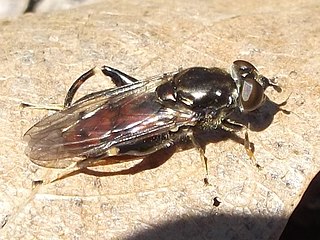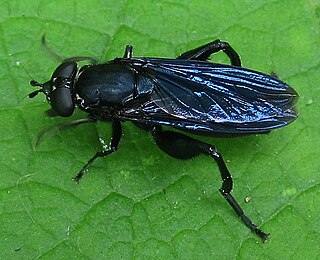
Syritta pipiens, sometimes called the thick-legged hoverfly, is one of the most common species in the insect family Syrphidae. This fly originates from Europe and is currently distributed across Eurasia and North America. They are fast and nimble fliers, and their larvae are found in wet, rotting organic matter such as garden compost, manure, and silage. The species is also commonly found in human-created environments such as most farmland, gardens, and urban parks, wherever there are flowers. This species is an important part of its native ecosystem as adult Syritta pipiens flies are critical pollinators for a variety of flowering plants and the species supports parasitism by various parasitic wasp species. Thus, they play an important role in environmental functionality, and can serve as bio-indicators, in which their abundance can reflect the health of the environment. Syritta pipiens looks like many predatory hoverfly species, yet is not predatory.

Tropidia is a genus hoverflies, from the family Syrphidae, in the order Diptera.

Somula decora, commonly known as the spotted wood fly, is an uncommon species of syrphid fly observed in central to eastern North America. Hoverflies can remain nearly motionless in flight. The adults are also known as flower flies for they are commonly found on flowers, from which they get both energy-giving nectar and protein-rich pollen. The larvae live in decaying wood.
Criorhina nigriventris , the bare-cheeked bumble fly, is an uncommon species of syrphid fly observed across the northern United States, the Appalachian Mountains and southern Canada. Hoverflies can remain nearly motionless in flight. The adults are also known as flower flies for they are commonly found on flowers, from which they get both energy-giving nectar and protein-rich pollen. The larvae of this genus are found in decaying wood.

Tropidia albistylum, the Yellow-thighed Thickleg Fly, is a rare species of syrphid fly observed across the eastern and central United States. Hoverflies can remain nearly motionless in flight. The adults are also known as flower flies for they are commonly found on flowers, from which they get both energy-giving nectar and protein-rich pollen. The larvae are aquatic.

Temnostoma alternans , the Wasp-like falsehorn, is a common species of syrphid fly observed throughout the northern and central United States and widespread in Canada. Hoverflies can remain nearly motionless in flight. The adults are also known as flower flies for they are commonly found on flowers, from which they get both energy-giving nectar and protein-rich pollen. Larvae burrow in moist decayed wood.

Brachypalpus oarus, the eastern catkin, is a common species of syrphid fly first officially described by Walker in 1849. Hoverflies get their names from the ability to remain nearly motionless while in flight. The adults are also known as flower flies for they are commonly found around and on flowers, from which they get both energy-giving nectar and protein-rich pollen. The larvae are of the rat-tailed type feeding on decaying sap under tree bark.

Temnostoma balyras , the Yellow-haired Falsehorn , is a common species of syrphid fly observed in the eastern half of the United States and adjacent areas of Canada. Hoverflies can remain nearly motionless in flight. The adults are also known as flower flies for they are commonly found on flowers, from which they get both energy-giving nectar and protein-rich pollen. Larvae burrow in moist decayed wood using their hooks as rasping organs operated in a forwards and backwards motion by huge muscles housed in the mesothorax and metathorax. The larvae of T.balyras have been described by Heiss in "A classification of the larvae and puparia of the Syrphidae of Illinois exclusive of aquatic forms".

Temnostoma barberi , the Bare-bellied Falsehorn, is a fairly common species of syrphid fly (hoverfly) observed in the eastern half of the United States and adjacent areas of Canada. Hoverflies can remain nearly motionless in flight. The adults are also known as flower flies for they are commonly found on flowers, from which they get both energy-giving nectar and protein-rich pollen. Temnostoma adults are strong wasp mimics. The larvae burrow in moist decayed wood.

Chalcosyrphus (Xylotomima) libo, the Long-haired Leafwalker, is an uncommon species of syrphid fly observed in north-central North America. Hoverflies are able to remain nearly motionless in flight. The adults are also known as flower flies for they are commonly found around and on flowers, from which they get both energy-giving nectar and protein-rich pollen.
Tropidia calcarata, the Lily-loving Thickleg Fly, is a rare species of syrphid fly observed from northeastern North America. Hoverflies can remain nearly motionless in flight. The adults are also known as flower flies for they are commonly found on flowers, from which they get both energy-giving nectar and protein-rich pollen. The larvae have been found on the rotting roots of an aquatic lily.

Chalcosyrphus (Xylotomima) chalybeus , the violet leafwalker, is a fairly common species of syrphid fly observed in the Northeastern United States. Hoverflies can remain nearly motionless in flight. The adults are also known as flower flies for they are commonly found on flowers, from which they get both energy-giving nectar and protein-rich pollen.

Temnostoma excentrica , the Black-spotted Falsehorn , is a common species of syrphid fly observed throughout the United States and Canada. Hoverflies can remain nearly motionless in flight. The adults are also known as flower flies for they are commonly found on flowers, from which they get both energy-giving nectar and protein-rich pollen. Temnostoma adults are strong wasp mimics. The larvae burrow in moist decayed wood.

Xylota flavifrons,, commonly known as the northern leafwalker, is an uncommon species of syrphid fly observed in the northeastern United States and all across Canada. Syrphid flies are also known as hover flies or flower flies because the adults are frequently found hovering around flowers from which they feed on nectar and pollen. Adults are 9.4–14.7 mm (0.37–0.58 in) long. The larvae of this genus live under bark in sap runs.
Sphegina flavimana, the Tuberculate Pufftail, is a fairly common species of syrphid fly observed in the northeastern United states and Canada. Hoverflies can remain nearly motionless in flight. The adults are also known as flower flies for they are commonly found on flowers, from which they get both energy-giving nectar and protein-rich pollen. Larvae are found in accumulations of decaying sap under bark, usually in wet situations such as damp, shaded woodland and in partially submerged wood in streams and pools.

Sphegina (Sphegina) keeniana, the Peg-legged Pufftail, is a fairly common species of syrphid fly observed in Eastern North America. Hoverflies can remain nearly motionless in flight. The adults are also known as flower flies for they are commonly found on flowers, from which they get both energy-giving nectar and protein-rich pollen. Larvae found in accumulations of decaying sap under bark, usually in wet situations such as damp, shaded woodland and in partially submerged wood in streams and pools.

Anasimyia chrysostoma, the lump-legged swamp fly , is a fairly common species of syrphid fly observed across the United States and Canada. Hoverflies can remain nearly motionless in flight. The adults are also known as flower flies for they are commonly found on flowers from which they get both energy-giving nectar and protein-rich pollen. Larvae of this genus are of the rat-tailed type living in aquatic environments.
Sphaerophoria asymmetrica , the asymmetric globetail , is a common species of syrphid fly observed across northern North America. Hoverflies can remain nearly motionless in flight. The adults are also known as flower flies for they are commonly found on flowers from which they get both energy-giving nectar and protein rich pollen. The larvae feed on aphids.
Total of 245 species either found or highly expected to be found in New York.














